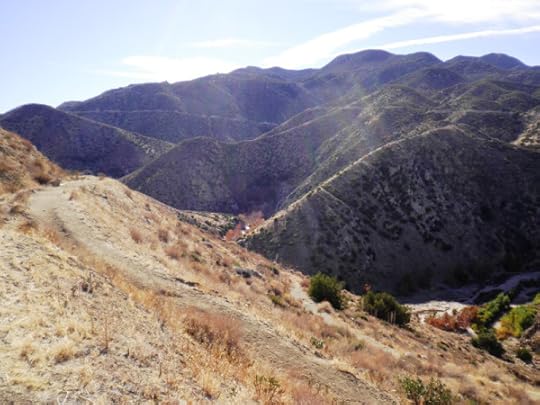Pat Bertram's Blog, page 177
December 7, 2014
You Matter Because
Click��here to find out more about the��YouMatter campaign
***
Pat Bertram is the author of the suspense novels Light Bringer, More Deaths Than One, A Spark of Heavenly Fire, and Daughter Am I. Bertram is also the author of Grief: The Great Yearning, ���an exquisite book, wrenching to read, and at the same time full of profound truths.��� Connect with Pat on Google+. Like Pat on Facebook.
Tagged: #youmatter, you matter campaign

December 6, 2014
A Welcome Rejection
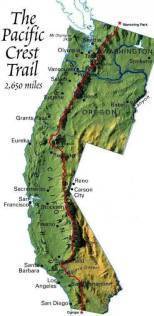 Usually rejections are accompanied by regret or demorialization, but I can honestly say this rejection comes as a welcome relief.
Usually rejections are accompanied by regret or demorialization, but I can honestly say this rejection comes as a welcome relief.
I had applied for a Pacific Crest Trail sponsorship, and today I got this message:
Thanks for applying to our mYAMAdventure program.�� This is the part of the program that I hate: I���m afraid we’re not able to extend an invitation to you this year.�� We received over 100 applications, and narrowing them down to just five was a true challenge.�� It���s a shame we can���t work with all of you.
I wish you all the best in your pursuits on the PCT!�� If you haven���t already, check out the following resources for a start with your planning:
Yogi���s PCT Handbook: http://www.yogisbooks.com/pacific-crest-trail/pct-yogis-pacific-crest-trail-handbook
pct-l mailing list: http://mailman.backcountry.net/mailman/listinfo/pct-l
Postholer forums: http://postholer.com/
Yay! Making the starting date for the hike��would have put too much pressure in my already stressed-to-the-limit life.��And it��would��not��have brought me the simplicity I crave. As I have learned, thru-hiking the Pacific Crest Trail is an athletic event where participants challenge themselves to complete the hike within the allotted weather window, more��of an obstacle race than��the transcendental walk I had envisioned!
So, where does this leave me? When I figure that out, I’ll let you know.
***
Pat Bertram is the author of the suspense novels Light Bringer, More Deaths Than One, A Spark of Heavenly Fire, and Daughter Am I. Bertram is also the author of Grief: The Great Yearning, ���an exquisite book, wrenching to read, and at the same time full of profound truths.��� Connect with Pat on Google+. Like Pat on Facebook.
Tagged: mYAMAdventure, Pacific Crest Trail, PCT, thru-hikers, thru-walking

December 5, 2014
Blog Tutuorial
I) Encapsulation of��How to Blog��Using WordPress
What you will mostly be doing��when you begin blogging is��a new post, so hover over your name on the right hand side of the black WordPress navigation strip on the top of the page and select��your blog��from the drop-down menu and click “new post.”��Or go to your dashboard and click on “new post” on��the left sidebar. Or click on “New Post” on the black navigation bar at the top of the page. That will take you to an article editor. (It’s similar to what you see when you write an email.) You type the title of your article in the title bar. Type your article into the body of the article editor, add tags and categories, then save as a draft to make sure you don���t lose it or to post on another day. Tags are individual keywords for search engines; categories are more of a general filing system. This sounds confusing, but truly, you will get the hang of it.
If you need more help than I offer in the following instructions, be sure to click ���help��� on the top right of your dashboard.
II) Basic Procedure:
To log in: go to http://wordpress.com \
2. Fill in your user name
3. Fill in your password.
4. Click on ���Log in.���
5. Hover over your name on the right hand side of the black WordPress navigation strip on the top of the page and select your blog. Then click on “dashboard” which will take you to the dashboard and all the bells and whistles. (I use the classic dashboard, so some of these instructions might be a bit different.) It’s hard to explain what everything is, so just play around with it. But what you will mostly be doing is a new post, so click “new post” from either the drop-down menu or from the left sidebar of the dashboard. That will take you to an article editor. If you don���t see the dropdown box and are on a page that shows ���Blogs I follow” or some such, click on ���My sites��� then click on ���dashboard��� and finally ���new post.���
6. Fill in the title. Then write your article into the body of the article editor. (Or cut and paste if you wrote it using ms word or any other word processor. This is what I do.)
7. Add tags���they are on the right sidebar. (Be sure to click on ���Add��� or they won���t get added to your article. Add categories. Click on whatever categories apply for your article, preferably no more than a couple. The total number of tags and categories should not exceed 10 combined. This is how people find your articles, so use a minimum of five total. 8. Click ���save draft.���
Your article is now saved in the drafts folder. Click on ���preview post��� to review what you have written; edit if necessary, then click ���save draft��� again. When you are ready to publish the article, click ���publish.���
Some bloggers write their articles ahead of time and save them in draft form until they need them. If you���ve saved your article as a draft, and later you need to find it, go to the dashboard, and off to the right you will see “recent drafts.” Click on the title of your article, click on publish. And you’re done. Click View Site (next to the name of the website) and double check to make sure your article looks the way you wanted it to. If not, click ���edit��� on the gray strip above your article, make your edits, then click ���update.���
III) Advanced Instructions:
1. ��Adding a photo to your article
Under the title bar, you will see: Add media. Click on that link. Then click on ���Upload photo.��� When the photo has been uploaded, choose left alignment if you want the text to wrap around the photo newspaper style, or choose center if you wish the photo to be centered on its own line. Choose the size (generally medium) then click ���insert into post.���
Editing the photo: If the image turns out to be the wrong size or you forgot to align it the way you want, do not delete it. This does not delete the photo from the blog, it only deletes it from your article. Instead, click on the photo, then click on the icon that looks like a photo. That will take you to the photo-editing box where you can change size and alignment. If by chance you delete the photo, click on the upload/insert icon, but do not upload another photo. Instead, click on Media Library at the top of the editor box, find your photo, click on it, and continue as if you���d just uploaded it.
1. Uploading icon/avatar/photo
It���s a good idea to have a gravatar so that people recognize you when you make a comment. This gravatar is also posted on the right sidebar of the blog. To upload an icon/avatar/photo:
Log in and go to your dashboard
On the left sidebar, down toward the bottom of the list, you will see “Profile” or “Users”
Click on the little arrow next to “Profile” or “Users” to get a dropdown list.
Click on “Your Profile”
In the top right hand corner, you will see a box with “My gravitar”
Click on “change gravitar” or “add gravitar.”
Click on “Upload an image from your computer” then upload image
Crop it as necessary. If your cropping tool doesn’t work (mine never does) go back (alt + left arrow) and try again. When you get it to the way you like, click on “Crop and finish”
Then close box.
3. Adding Tags
Categories are a way of filing the articles, which is important, but tags are every bit as important. Tags are what search engines look for, and so they bring people to the site. WordPress tags are weird in that you can’t just type them into the tag box then click on draft. You have to type the tags in the box and then click on “Add.” To me, the hardest and most consuming part of blogging is tagging. I go through the article line by line and if there is anything “searchable” I put it in the tags. For example, if you mention Gone With the Wind, even in passing, that should be put in the tags. So should “Margaret Mitchell.” Since tags are also a way of finding your posts later (your own private filing system), you can add the theme as a tag or anything else that will make it easy to find your post using the search box on the blog. (If you don���t have a search box on your blog, then add them from available widgets.) Once you have everything tagged, be sure to hit “add” or all those tags disappear. (I know this because I make that mistake when I am in a hurry.) So what do you do when you realize that your published post has no tags? Go to the blog, click on the title, and up on the gray bar you will see “edit post.” Click on that, add your tags — making sure you click “add” — then click on “update post.
4. Display name
Make sure your display name on comments is your author name. You want people to know who you are so that you can build your online author persona.
To change your display name to your author name:
Go to “Users” and click on “your profile.” Scroll down to where you see “display name publicly as”. Put in your author name, or whatever name you want people to see, then click ���update profile.���
5. Linking your name to your blog
The internet is all about links, and the most important link is the link attached to your name. If you make a comment, and your name is not linked to anything, you become a dead end.
To link your name to your website or WordPress blog (preferably your blog, in case you ever have a problem with WordPress and have to contact support) go to “Users” on your dashboard, click on “your profile.” Scroll down to “contact information.” In the blank for “website” put in your entire blog address, including the http://
Then click save. Now, when you make a comment on WordPress, and someone wants to know more about you, all they have to do is click on your name.
6. Adding Clickable Links to Your Blog Post:
The internet is created of links. Without links there are no websites, no way to navigate from one place to another, no way of connecting the dots. Whenever you mention your book, be sure to link to somewhere your book is available.)
To make a clickable link on a photo on WordPress: after you upload a photo to an article, click on ���custom URL��� then copy and paste the URL for the page of the book or author or whatever. Then click ���insert into post.���
To make a clickable link for text on WordPress: Before you save your article to draft, select the words the same way you do for a MSWord document, then click on the icon in the WordPress tool bar that looks like a bit of a chain. In the “insert link” box that appears, cut and paste the URL of the book, website or whatever you wish to link to, then click “insert.” That’s all there is too it. If you forget to add links, you can click “edit” on a published article and add the links.
IV) Improve Your Blog
Please make use of the most important features available on WordPress. Simply having a list of categories or dates tells readers nothing. If you will notice on my blog I have a list of “recent posts” and “top posts.” Once people are on the site, often the title of another post catches their eye, and they click on it. This increases the views of the blog and hence the rating.
If you hover your mouse over the title of your blog in the left hand side of the wordpress tool bar, you will get a drop down list. Click on “widgets.”
Find the widgets you’d like to add to your blog, such as “recent posts”, “top posts and pages,” ���search,���and drag them to the column marked “sidebar.” Sometimes, depending on the theme you choose, you have two sidebars, both a right and a left, so drag the widgets to wherever you want to place them. Fill in the information requested, such as “title” and “number of posts you want to show,” then click save.
Other important widgets — The “follow” widget will add a place for people to sign up to receive notifications of your blog posts. The “facebook-like” widget allows people to like your facebook page from your blog.
Use “image” to add the cover of your book to your sidebar, use text if there is something you’d like people to see (for example, on my blog, I use the text widget in the top of my left sidebar for a brief bio and a listing of my books with links to Smashwords.)
Use the “links” widget to add a blogroll — a list of other blogs you like. I use the blogroll as a reciprocal favor for people who have listed me on their blog rolls or who frequently comment on my blog. I’ve also added a “search” box to make it easier for people to search the site.
You don’t have to add all of these widgets, of course. We���re just showing you what is available and how to improve your blog.
V) Themes
I should touch on themes in this tutorial, though that could be a whole tutorial in itself. The theme is the blog format, and there are hundreds to choose from. When you sign up for WordPress, they have a video tutorial to help you get started. If you miss that or decide to change the look of your blog, go to your dashboard, scroll down the left hand sidebar, hover your mouse over ���appearance��� and click on ���themes.��� If you see something you like, click on preview to see how it will fit on your blog. Then, if you like it, click ���activate.���
VI) Most Important Blogging Tips
Experiment with the various tools WordPress offers.
Explore the site and topics without fear —��Wordpress is intuitive, so whatever you need or think you need, you will easily find. There are also multiple ways of doing most things, so find the ways that are most comfortable for you
Excite yourself and your readers with engaging posts. Have fun. If you treat blogging as a chore, so will your potential readers, and drudgery will make them bolt to a more compelling blog.

***
Pat Bertram is the author of the suspense novels Light Bringer, More Deaths Than One, A Spark of Heavenly Fire, and Daughter Am I. Bertram is also the author of Grief: The Great Yearning, ���an exquisite book, wrenching to read, and at the same time full of profound truths.��� Connect with Pat on Google+. Like Pat on Facebook.
Tagged: basic blogging, Blogging tips, blogging tutorial, how to blog, improving your blog, most important blogging tip, starting to blog

December 4, 2014
Using Dance
When I told an acquaintance I was taking classical dance lessons — ballet, jazz, tap — she gave me a blank-eyed stare and said, ���How do you use it?��� From her point of view, the question apparently seemed logical. She had once taken ballroom dancing, and she could use her skill if/when she went to a ballroom or nightclub or wherever such dancing takes place. I have no corresponding ���use��� for classical dancing, though I have been invited to participate in a few performances so I have used some of the dances I know.
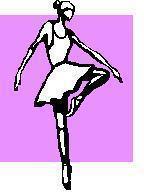 Still, in the year and a third that I���ve been going to class, I never once considered whether there was a use for dancing. If anything, it���s more that dance has a use for me. It takes me beyond myself and at the same time, takes me into myself, making me more comfortable with who I am than I���ve ever been in my entire life. (I think it has something to do with living in front of a mirror for all those hours each week.) It���s the only thing I���ve ever done that demands all of me — mind, body, spirit, strength, dedication, loyalty. (I listed ���mind��� first without even thinking about it, and I was going to change the order to put body first, but this is the right order. Without the mind — learning, memory, imagining — there is no dance.)
Still, in the year and a third that I���ve been going to class, I never once considered whether there was a use for dancing. If anything, it���s more that dance has a use for me. It takes me beyond myself and at the same time, takes me into myself, making me more comfortable with who I am than I���ve ever been in my entire life. (I think it has something to do with living in front of a mirror for all those hours each week.) It���s the only thing I���ve ever done that demands all of me — mind, body, spirit, strength, dedication, loyalty. (I listed ���mind��� first without even thinking about it, and I was going to change the order to put body first, but this is the right order. Without the mind — learning, memory, imagining — there is no dance.)
Dance is a generous taskmaster and gives back more than it demands. Although I am nowhere near as graceful, balanced, and strong as I would like to be, I have come a long way since I began taking lessons. I can feel muscles now where there used to be . . . whatever there used to be. And I am a bit more balanced and��graceful than I was before. Best of all, these benefits will remain with me even when I can no longer take dance classes.
There���s no need to ���use��� dance. Dance is its own reason for being.
***
Pat Bertram is the author of the suspense novels Light Bringer, More Deaths Than One, A Spark of Heavenly Fire, and Daughter Am I. Bertram is also the author of Grief: The Great Yearning, ���an exquisite book, wrenching to read, and at the same time full of profound truths.��� Connect with Pat on Google+. Like Pat on Facebook.
Tagged: ballet, classical dance lessons, jazz, tap, using dance

December 3, 2014
You Matter
I received this letter yesterday:
Dear Pat,
Give more than presents this holiday season, share the gift of caring with those who matter to you most!
With the holidays around the corner, the USC School of Social Work believes that there is no better time to encourage random acts of kindness. The simple act of telling someone why they matter could have a bigger impact than you know. For that reason, you���re invited to participate in You Matter, a grassroots campaign designed to foster well-being and bring back some much-needed human connection. We are on a mission to spread as much positivity as possible, and we hope that you���ll join us!
There are four easy steps to participate in #YouMatter:
1) Download a Care Card from the MSW@USC blog.
2) Write a message with someone in mind.
3) Snap a picture of your card and share on social media using the hashtag #youmatter and tag us @youmatterbc to inspire others.
4) Give the Care Card to someone and make that person���s day!
There���s never a better time than now to show others that that they matter in this world. If you love this campaign as much as we do, we ask that you please pay it forward by featuring #YouMatter on your blog.
Wishing you a wonderful and safe holiday season,
Gaby Acosta
####
Sounds like an interesting campaign, even if she did neglect to tell me I matter!
If you’re interested in participating in this project, here is a “you matter” template to use. (Just right click and “save��image as…) I was going to fill in the template, but in the end decided there was no “because.” You matter. It’s as simple as that.
***
Pat Bertram is the author of the suspense novels Light Bringer, More Deaths Than One, A Spark of Heavenly Fire, and Daughter Am I. Bertram is also the author of Grief: The Great Yearning, ���an exquisite book, wrenching to read, and at the same time full of profound truths.��� Connect with Pat on Google+. Like Pat on Facebook.
Tagged: #youmatter, care card, USC School of Social Work, you matter campaign

December 2, 2014
Stressed to My Limits
I���m sitting here, wondering if I should write this post. I don���t want to make anyone feel bad, so I���m hoping the women involved don���t read this or if they do that they don���t fret, and yet, ever since my life mate/soul mate died, I���ve tried to write my truth.
I had lunch today with some friends after dance class. (Got to replenish those��expended calories!) I was the only single woman at the table. All the rest were divorced and remarried. Not that their marital state is a problem for me anymore. I���ve gotten used to being the only uncoupled person in most situations. Nor did I think anything of their topic of conversation at first. I���ve heard it before — they all contend that losing a husband to divorce is worse than losing him to death because with divorce, he���s still around, especially if there are offspring involved.
But today I am feeling fragile. It���s only been a month since my father���s death, and although I am not grieving him the way I grieved for Jeff, my life mate/soul mate, my father���s demise has upset my equilibrium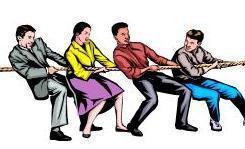 . I am aware of his empty place at the couch, his books, reading glasses, and magnifier stacked neatly the way he left them. I know he led a long and happy life, but his absence still is ever present.
. I am aware of his empty place at the couch, his books, reading glasses, and magnifier stacked neatly the way he left them. I know he led a long and happy life, but his absence still is ever present.
Even worse, this is the second time in less than five years that my living situation has been thrown into upheaval by death, and this time I do not have a fall back position. The whole world lies open before me, but I don���t know what to do with it. To add to the complications, I need to pack in anticipation of leaving this house, which will be put on the market in a few weeks. I���d already gotten rid of the bulk of Jeff���s things before I came here, but what remains are ���our things��� along with what is left of his effects — things so emotionally laden that I simply could not dispose of them during that worst day of my life when I cleaned out his closet and drawers and prized possessions. And now I have to figure out what to do with it all. Oddly, the only thing so far that set off an emotional storm was the container of refrigerator magnets we used to use. Other things, like his favorite jacket and the sweater he wore when we met, I stoicly repacked because I still can���t deal with them.
Did I mention the sun sets at 4:30 around here? And I am prone to SAD (seasonal affective disorder).
So this was my state of mind as I listened to my lunch companions talk. And oh, my poor heart ached. I would give anything to see Jeff one more time. Even if he had gone to be with another woman and left me destitute in the process, I would still be glad to know that he was alive and well. I���d be angry, of course, heartbroken and humiliated, but I so loved him that his well-being meant more to me than my own. (I���m only now learning to put myself first, but that could be because there���s no one left in my life to care about that deeply. I���ve lost them all one way or another — Jeff, the two brothers closest to me in age, my parents, a very special friend.)
I no longer know who has it worst when it comes to grief — the divorced, the widowed, those who lost a child, parent, lover, sibling, best friend, pet. I no longer care. We all suffer heartache and grief in our lives. We all deal with it as best as we can (or let it deal with us). In my case, this conversation��mostly served to��show me how vulnerable I still am, how much I still miss him, how much his being dead��is still a part of my life.
God may provide, the universe might be unfolding as it should be, everything could be falling into place, my destiny might be waiting, life could be what is happening while I am making other plans (or whatever aphorism it is that you believe), but the truth is, at the moment, I am stressed to the limits.
I keep saying that however things turn out, I���ll be okay. And I mean it. Just not today.
***
Pat Bertram is the author of the suspense novels Light Bringer, More Deaths Than One, A Spark of Heavenly Fire, and Daughter Am I. Bertram is also the author of Grief: The Great Yearning, ���an exquisite book, wrenching to read, and at the same time full of profound truths.��� Connect with Pat on Google+. Like Pat on Facebook.
Tagged: death, death of a father, death of a life mate, divorced vs widowed, seasonal affective disorder, uncoupled

December 1, 2014
Sorting and Storing and Stewing
I���ve spent the last couple of mornings sorting through my stuff, disposing of some, repacking the rest.
It���s hard because I need to be hard on myself. Do I really need three sets of pots and pans, a dozen assorted knives, and two sets of flatware? (His and mine.) Do I really need six lamps? (All ours.) What do I need to pack for long-term storage? What might I need in the next few months?
And it���s hard because I don���t know what life I am packing for. I plan to stay in this vicinity for a while longer, though I have no idea what that ���stay��� will involve since I don���t know how long I will be allowed to live in my father���s house, and the very thought of renting an apartment and settling down for the duration of a lease gives me the willies.
[Just spent an hour looking for the origin of the phrase ���gives me the willies.��� Apparently, it���s been around for hundreds of years since it shows up in print in the nineteenth century. Though there is much speculation about the origins of this particular phrase, no one knows for sure. One possibility comes from William Morris, the Word Detective, who speculates that willies might come from the name of a Slavic sprite called a vila (plural vili ���sprites���) sometimes translated as wili.]
Nor do I know what my life will be like a few months from now. Will I give in to the need to be mobile and deal with the discomforts and dangers of being a nomad? Will I give in to the need to be warm and comfortable and deal w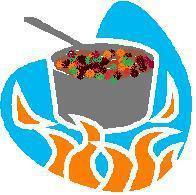 ith the stagnation and entropy of being settled? If I opt to be a nomad, will I get a camper, or set out on foot? If I opt to settle down, will I find a place here or in Colorado?
ith the stagnation and entropy of being settled? If I opt to be a nomad, will I get a camper, or set out on foot? If I opt to settle down, will I find a place here or in Colorado?
Still, despite the difficulty of sorting through my stuff (and despite detours to look up��unfamilar etymologies), I am making progress. I figure several months after the house is sold and the new people have moved in, I���ll be ready to leave here. I wonder if the new people��will mind that their guest room comes with a ready-made guest. I���m thinking yes, they���d mind, so I���d better get back to my sorting and storing and stewing over my future.
The way I figure it, though, however things turn out, I���ll be okay. It���s the uncertainly of getting to where things have turned out that gives me something to try not to stew over.
***
Pat Bertram is the author of the suspense novels Light Bringer, More Deaths Than One, A Spark of Heavenly Fire, and Daughter Am I. Bertram is also the author of Grief: The Great Yearning, ���an exquisite book, wrenching to read, and at the same time full of profound truths.��� Connect with Pat on Google+. Like Pat on Facebook.
Tagged: etymology, gives me the willies, moving, packing, stew over, word detective

November 30, 2014
Bah Humbug
I went to see a movie at a theater today, the first time in maybe thirty years. (Yeah, came as a shock to me too when I realized that.) And it might be another thirty years before I go to a��movie theater��again — for sure the friend I went with will not invite me a second time. I didn���t have the proper attitude, I guess.
W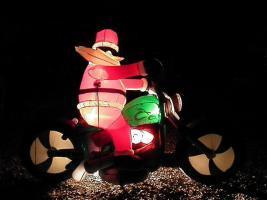 e saw a kid���s Christmas movie that was cute enough, but it seemed like just another stale story with an emphasis on the importance of believing in Santa Claus. Maybe the problem for me is that I never did get the whole Santa Claus thing, don���t understand why it is so vital to believe that particular myth especially since Santa has nothing to do with what used to be a religious celebration.
e saw a kid���s Christmas movie that was cute enough, but it seemed like just another stale story with an emphasis on the importance of believing in Santa Claus. Maybe the problem for me is that I never did get the whole Santa Claus thing, don���t understand why it is so vital to believe that particular myth especially since Santa has nothing to do with what used to be a religious celebration.
Although I never thought of Santa as real, I didn���t feel any less magic during the season because of the lack. In fact, I do not know of a single classmate who did believe the Santa Claus myth. There really was no way to believe since our parents insisted on our writing thank you notes to everyone who gave us a present. And for me, since I have always had a need to��understand and an overweening sense of fairness, it made sense that the rich kids got a lot of presents and the not so rich only a few. But if Santa really did bring the gifts��— well, he played favorites and so wasn’t worth believing in.
Mostly, for us, Santa was a store decoration, a cartoonish symbol of the season. What occupied our childish imaginations were the lights, the tree, the stockings, the cr��che, the department store windows, the bustle to buy what gifts we could, making a Christmas list for our parents, the wonderful smell of holiday treats baking, the speculation of what the gifts under the tree might be, and even sometimes, the majestic church service.
And yet almost every kid���s Christmas movie emphasizes the need to believe in Santa Claus. Often, the child character is starting to disbelieve, but after meeting Santa or going to the North Pole or getting a visit from an elf, magically the child���s belief in the red-garbed gent is reinstated, which to me negates the whole theme of believing. If you see that something exists, it���s not ���believing��� — it���s ���knowing.��� If the child character sees such a mythical place as the North Pole peopled with elves and flying reindeer, then the belief would be fortified even if the kid didn���t see Santa, so again, a choice to belief in Santa is no stretch of the imagination.
I suppose belief is an important attribute, but what one believes should be more significant than a once-a-year mythic character.
Yeah, I know — I don���t have the proper attitude. It was just a kid���s movie, after all, and not at all worth mulling over. And yet, here I am, bah humbugging.
***
Pat Bertram is the author of the suspense novels Light Bringer, More Deaths Than One, A Spark of Heavenly Fire, and Daughter Am I. Bertram is also the author of Grief: The Great Yearning, ���an exquisite book, wrenching to read, and at the same time full of profound truths.��� Connect with Pat on Google+. Like Pat on Facebook.
Tagged: bah humbug, belief in Santa Claus, Christmas, Santa Claus, the Santa Claus myth

November 29, 2014
An Easy Hike
I haven���t been on any hikes recently. I���ve been taking a couple of extra dance classes and also preparing for a show (my class will be doing two numbers at a dance performance��put on by��the local college next weekend), and I wanted to make sure I didn���t jeopardize that privilege by overdoing it. My body is used to the extra classes now, so when a friend invited me to go on an easy group hike with her this morning, I accepted. It didn���t seem like it would be a very scenic hike — it was more to explore a water system from the 1800s than to enjoy the scenery — but I���ve been trying to walk more in preparation for . . . I still don���t know what. Some sort of long, long, long walk perhaps. And this seemed a perfect opportunity to stretch myself a bit.
We met at a nearby dam and signed in. Since the Sierra Club sponsored the hike, we had to sign a waiver. I didn���t think anything of it — after all, I���d done Sierra Club hikes before, and anyway, it was an easy hike, only three miles, according to the English chap who led the group.
The scenery at our meeting place wasn���t very inspiring — just a lot of dirt bike trails carved haphazardly out of the desert floor by bikers — but after we climbed through the gate meant to keep out cars, and walked leisurely across the top of the dam, there were some pretty sights, including this rare��example of fall colors in the desert.
We took a��break so everyone could catch up to the leader, and then we continued up the path. The operative word here is ���up.��� The path started with a gentle incline that got steeper and steeper as we climbed. At one point, the only way I could make it up��a sharper than 45-degree angle was on hands and knees. Embarrassing, but effective.
Our leader promised us that��was��the hardest part of the hike, but then we started our even steeper descent on sand and scree. (I had to pause here and reflect. I don���t think I���ve ever used the word ���scree��� in my entire life, never had reason to. Amazingly, I was able to dredge the correct word out of my magpie brain.) I wish I could announce that I descended that hill gracefully, but once (okay, I admit it — twice) my feet slid out from beneath me and I ended up ���bum sledding��� as the English chap called it.
���It���s easy from here,��� the chap said when we all made it (one way or another) to the bottom of the path. ���Easy from here?��� I responded. ���Wasn���t the whole hike supposed to be easy?��� He said, ���When we get back, it always seems to have been so easy.���
But we weren���t yet back. There was still a rusted and rotted water pipe to hike along for several yards (someone suggested that I use my trekking pole as a balancing pole, and it worked! Or maybe it���s all those relev��s I���ve��been doing��in ballet class.) After the water pipe episode, we had to wade through a sand field where my legs sunk halfway up to my knees, ford a river, and climb one last 45-degree hill.
We returned to the cars three and a half hours after we started. Allowing a generous hour for breaks and a snack, we���d been hiking for at least two and a half grueling hours. Even at my slowest uphill pace, I walk a mile in thirty minutes, so I have no idea how long the hike really was. At least four, but probably closer to five miles.
We gathered around for a brief post-hike retrospective. The English chap asked if anyone was hurt. We all took stock and admitted we were fine.
He beamed at me and said, ���See? An easy hike.���
***
Pat Bertram is the author of the suspense novels Light Bringer, More Deaths Than One, A Spark of Heavenly Fire, and Daughter Am I. Bertram is also the author of Grief: The Great Yearning, ���an exquisite book, wrenching to read, and at the same time full of profound truths.��� Connect with Pat on Google+. Like Pat on Facebook.
Tagged: fall colors in the desert, group hike, hiking in the desert, Sierra Club

November 28, 2014
The Importance of Links
I visited a friend���s blog the other day and followed some links back to an older post I’d missed, where I left a comment. The blogger contacted me, expressing concern that I got hacked because a) I seldom leave comments — yeah, I know, it���s terrible of me; I���m lucky I have time to respond to the comments so kindly left on my own blog and b) it was an older post.
 That episode reminded me of the lastingness of blog posts. (Is lastingness a word? Spellchecker seems to think so. I don���t see that squiggly red line that so often berates me.) Some of my most visited blog posts are older ones — a few from my ���writing hints��� days, a couple from my ���anything goes��� days, and several from my early grief days.
That episode reminded me of the lastingness of blog posts. (Is lastingness a word? Spellchecker seems to think so. I don���t see that squiggly red line that so often berates me.) Some of my most visited blog posts are older ones — a few from my ���writing hints��� days, a couple from my ���anything goes��� days, and several from my early grief days.
Because blog posts are eternal, as eternal as the internet is anyway, the links we include are important.
In the case of my blogger friend, the links I followed were generated by Word Press, so they were all live links. In the case of links we add to our blogs — well, that���s a different story, especially when it comes to my blog. The links to older blog posts that I add to current blog posts are good — I never change the domain or the URL, so those links all work. But links I posted that link to other websites . . . yikes.
I used to link all my books to a certain independent bookseller���s website. Mostly I did it out of��loyalty since all those links helped the ranking of the website, but doing so also served as a salvo in my own private war against Amazon. It seemed to me that Amazon overruns its banks and floods everything in its path, and I wanted to do what I could to��stem the rushing waters. But I miscalculated, and now the Amazon river gods are laughing at me. Most of the book links in my blogs now go somewhere besides the requisite book page on that independent bookseller���s site, and I have yet to fix the more than five thousand links I have posted over the years. The current links all work (I capitulated and now they go to my book pages on Amazon) but the links in older posts, well, let���s just say they���re defunct and leave it at that.
The webmasters of that other site didn���t seem to see the importance of redirecting the links when the company changed domains, and I could not convince them otherwise. The web is all about links — if there were no links, we���d never be able to move from one page to another. It���s the links that make the internet an interconnecting network. It’s the links that make the web a web. And because the network/web is eternal, those links are eternal. And now I have an eternity of defunct links.
I���m gradually changing the links, but if you ever click on a link that doesn���t take you to the proper page, please let me know so I can fix it.
Thank you.
***
Pat Bertram is the author of the suspense novels Light Bringer, More Deaths Than One, A Spark of Heavenly Fire, and Daughter Am I. Bertram is also the author of Grief: The Great Yearning, ���an exquisite book, wrenching to read, and at the same time full of profound truths.��� Connect with Pat on Google+. Like Pat on Facebook.
Tagged: Amazon, importance of links, interconnected links, the internet as interconnected links, the web as a web of links





